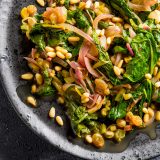Many green vegetables—from broccoli and broccolini to thick-stemmed asparagus and chard—present the same cooking challenge: The sturdy stems invariably take longer to cook than the tender tops. And too often this means we end up with overcooked, mushy greens or fibrously tough stems.
Thankfully, we’ve found that the solution is simple: Treat the tops and bottoms as two separate ingredients.
This works with most any stovetop recipe. We start by trimming off the tender bits, the broccoli or broccolini florets, the thinner upper lengths of the asparagus, the leafy tops of the chard. Those we set aside.
We begin the cooking with the stems, giving them a head start in the pan. After a few minutes, when they begin to soften, we only then add the tender bits. Since they spend far less time in the pan than the stems, the result is perfectly cooked greens from top to bottom.
We use this technique with a Mediterranean take on chard, one that balances the bitterness of the leaves with sweet onion, golden raisins and a bit of honey. It’s a great example of agrodolce, the Italian balancing of bitter and sweet.
Toasted pine nuts add texture and a roasted depth, and red pepper flakes contribute mild heat. Pungent sherry vinegar adds both acidity and woodsy complexity for a bright dish with silky leaves and tender-crisp stems.
Everything balanced. Perfectly.
Pine nuts have a buttery, resinous flavor with a slight sweetness. Perhaps best known as a key component of pesto Genovese, they add nutty-rich flavor and, when used whole, pops of pleasant chew. But they also can be quite expensive and have a limited shelf life thanks to their high fat content. So it helps to know what to buy and how to make the most of them.
Italian stone pine nuts (Pinus pinea) and Chinese or Siberian pine nuts (Pinus siberica) are most common in the U.S. Italian varieties are large and slender with strong piney notes, while Chinese and Siberian varieties are smaller and pointed with sweeter, milder flavor.
When testing widely available supermarket brands, we were pleasantly surprised that only one package tasted rancid. And it was the only one that didn’t display a use-by date. So we suggest always looking for packages with clearly indicated expirations. We found that Diamond and Pastene brand pine nuts were the smallest and sweetest nuts, while medium-sized Badia had nice piney flavor.
Pine nuts should be stored in an airtight container in the refrigerator or freezer. Sold raw, they should be toasted (but carefully, to prevent burning) before use in most recipes. Start them in a cold skillet over medium-low heat and stir constantly until lightly browned, 3 to 4 minutes. Or spread them on a baking sheet and toast in a 300°F oven, stirring now and again, until golden, 8 to 10 minutes. Either way, be certain to remove them from the pan immediately so they don’t continue to toast in the residual heat.







